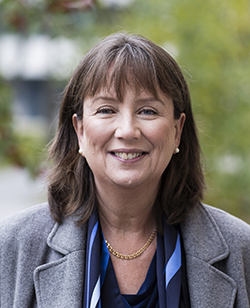Swedish universities develop comprehensive framework for their climate work
A collection of 36 Swedish universities and colleges have created a combined climate framework to serve as the basis for individual climate strategies, with the goal of coming into line with the Paris agreement’s 1.5C warming limit by the year 2030. This ambitious plan aims to both reduce direct emissions and increase involvement in societal climate questions.

The latest IPCC report from the UN’s climate panel showed that efforts to halt climate change must increase drastically if global warming is to be kept below two degrees. To achieve that climate goal, which Sweden and other countries have signed up to via the Paris agreement, emissions need to be roughly halved every decade.
That will require rapid changes to society as a whole. All sectors will be influenced. Universities and colleges have several roles to play in this process, including core missions which are now more important than ever.
- To research climate change – both how to combat it, and how we can adjust to manage it.
- To educate the citizens and leaders who can carry out the actions required.
- To develop solutions to reduce greenhouse gas emissions and also remove previously emitted carbon dioxide from the atmosphere. And, to be involved in implementation of those solutions.
- To spread awareness of new scientific knowledge.
For the higher education sector in general, it is these activities that have the biggest potential for contributing meaningful climate action. They are part of the climate framework.
But the framework also aims to reduce those climate emissions directly linked to universities’ own operations. One of the biggest factors here is travel, particularly by plane. Tackling this source of carbon dioxide emissions is a challenge for universities, because of the highly international aspect of much of the work. The framework is therefore vital as a collaborative tool, and the signed-up universities and colleges will meet annually to cooperate in this area.
The initiative for the climate framework comes from KTH Royal University of Technology and Chalmers University of Technology.

“Because reducing emissions is such an urgent need, it is not enough to just focus on technical solutions,” says Chalmers President Stefan Bengtsson. “Behavioural changes are needed too, and this of course concerns universities as well. We are some of the country’s largest employers. It is important to show too that we actually take our own research on climate change seriously.”
“The higher education sector has a comprehensive responsibility to develop the understanding of climate issues, and their solutions,” says KTH President Sigbritt Karlsson. “To simply pass that responsibility on to coming generations is not good enough. We must act now, on several levels simultaneously.”
Institutions who have signed up to the climate framework:
- Beckmans College of Design
- Blekinge Institute of Technology
- Chalmers University of Technology
- Stockholm School of Theology
- Ersta Sköndal Bräcke University College
- Swedish Defence University
- Swedish School of Sport and Health Sciences, GIH
- Stockholm School of Economics
- University of Borås
- Dalarna University College
- Gävle University College
- Halmstad University
- Kristianstad University
- University of Skövde
- University College West
- Jönköping University
- Karlstad University
- Karolinska Institute
- Konstfack, University of Arts, Crafts and Design
- Royal Institute of Art
- Royal College of Music, Stockholm
- KTH Royal Institute of Technology
- Linköping University
- Linnaeus University
- Luleå University of Technology
- Lund University
- Malmö University
- Mid Sweden University
- Mälardalen University College
- Newman Institute
- Red Cross University College of Nursing
- Sophiahemmet University College
- Swedish University of Agricultural Sciences
- Södertörn University
- Umeå University
- Örebro University
More on the climate framework:
The climate framework describes how universities and colleges should involve themselves in measures to lessen damage to the climate. The signed-up institutions recognise the climate as an essential and high-priority future issue and agree to the following.
- To continue contributing to society in ways such that climate goals can be achieved, through education, research and collaboration.
- To reduce their own climate impact, and by 2030 have introduced measures to be in line with the 1.5C warming limit.
- To set up long-term goals for climate work and dedicate resources to achieving those goals and carrying out follow-up measures.
- To clearly communicate their climate work, to inspire and spread knowledge to other actors and wider society.
The climate framework is connected to guidelines which describes a number of key areas where the higher education sector can influence society and suggests measures for reducing climate impact. The guidelines can help each university to choose the areas they will work most on, defining the goals and measures required based on their own situation.
More on: the climate measures needed
The latest report from the Intergovernmental Panel on Climate Change, the IPCC, underlined the seriousness of climate change and the urgency with which it needs to be addressed. The report showed that already a warming of 1.5C would result in serious consequences, and that this would markedly increase with a warming of 2 degrees. The current measures to combat climate change, made by various countries, will still lead to a warming of at least 3 degrees this century, with further increases after that.
To keep warming below 2 degrees and strive for the 1.5 degree target of the Paris agreement, global emissions will need to reduce by about 50 percent per decade, becoming climate neutral around the middle of this century, and thereafter achieve negative emissions. For Sweden, equivalent goals exist through the national climate policy framework. If the reduction in emissions is not fast enough, there is a risk that the climate could pass a critical point where the temperature increase becomes self-reinforcing.
Between 2017 and 18 Sweden’s emissions actually increased and no clear reduction in Swedish emissions has occurred since 2014.
Author: Jill Klackenberg
For more information, please contact:
- Göran Finnveden, Vice President for Sustainable Development, KTH,
+46 8-790 7318, goranfi@kth.se - Fredrik Hörstedt, Vice President for Utilisation and Sustainable Development, Chalmers,
+46 31-772 43 22, fredrik.horstedt@chalmers.se